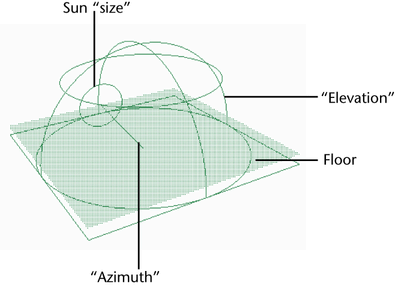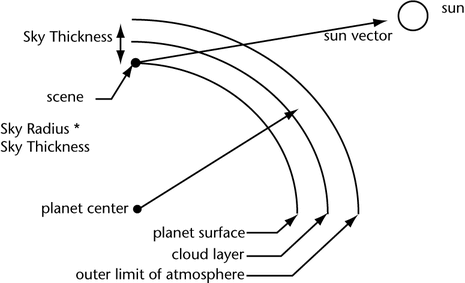Simulates a planetary environment viewed from the surface of a planet.
Find this texture in the Create bar.
If the eye point or view drops below the floor, the Env Sky texture swatch turns red as a warning. If you render the scene, the floor appears red. To avoid this, make sure the eye point is always above the floor (the grid plane).
Interactively adjusting Sun attributes
The following attributes relate directly to the Sky’s texture placement object. You can use the Maya transform tools, such as Scale and Rotate to place the manipulator, or use the Show Manipulator tool.
As you change the settings for Elevation, Azimuth, and Size attributes, notice how the various manipulators adjust in the View. IPR render to watch the texture change on the object.
The following indicates which manipulators correspond to which attribute.


The density of the air in the atmosphere. The denser the air, the more light is scattered.
Air density represents low and high altitudes. High altitude skies are almost black straight up and blue near the horizon (the Air Density value less than 1). Low altitude skies are blue straight up and white near the horizon (the Air Density value greater than 1). The slider range is 0 to 3. The default value is 1.
The outer radius of the sky as a multiple of Sky Thickness.
Sky Thickness and Sky Radius values determine the planet radius, and planet radius influences the appearance of sunsets. A planet with a large radius results in very red (and very dark) sunsets (you can adjust Sky Brightness to compensate for sunsets that are too dark). The valid range is 0 to infinity. The slider range is 0.01 to 300. The default value is 50.
For example, if Sky Thickness is 1000 and Sky Radius is 50, the outer radius of the sky is 1000 x 50 = 50 000 units, and the radius of the planet is (1000 x 50) - (1000 x 1) = 49 000 units.
The brightness and color of cloud illumination when the sun is below the horizon and the clouds are front lit (for example, when the sun’s Elevation value is 0 and its Azimuth value is 180).
This is a very subtle effect and occurs only briefly in nature during a sunrise or sunset. The effect is more noticeable with high altitude clouds. The default color Value is 1.
A threshold value for the Cloud texture that controls how much of the sky is covered with cloud.
As the Threshold value increases, darker areas of the texture do not produce clouds. The valid range is 0 to infinity. The slider range is 0 (entire sky is cloudy) to 1 (no clouds). The default value is 0.5.
The clouds are scaled and positioned by adjusting the Power value.
The cloud density is achieved by subtracting the Threshold from the pixel value clipping to 0, then multiplying the result with Density. To control the amount of de-focusing of the Cloud Texture, adjust the Blur value (under Sun Parameters). The valid range is 0 to infinity. The slider range is 0 to 1. The default value is 1.
The size (radius) of cloud illumination from direct back lighting by the sun (for example, when the sun’s Azimuth value is 0).
Direct back lighting is most noticeable near the edges of thick clouds or through thin clouds. The valid range is 0 to infinity. The slider range is 0 to 50. The default value is 20.
The Calculation Quality attributes control the rendering speed of an Env Sky texture.
The calculations required for curved atmospheres reduce speed. The Calculation Quality attributes do not greatly affect the appearance of the sky, but do affect the speed at which the calculations are computed.